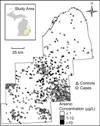Lifetime exposure to arsenic in drinking water and bladder cancer: a population-based case-control study in Michigan, USA
- PMID: 20084543
- PMCID: PMC3962589
- DOI: 10.1007/s10552-010-9503-z
Lifetime exposure to arsenic in drinking water and bladder cancer: a population-based case-control study in Michigan, USA
Abstract
Objective: Arsenic in drinking water has been linked with the risk of urinary bladder cancer, but the dose-response relationships for arsenic exposures below 100 microg/L remain equivocal. We conducted a population-based case-control study in southeastern Michigan, USA, where approximately 230,000 people were exposed to arsenic concentrations between 10 and 100 microg/L.
Methods: This study included 411 bladder cancer cases diagnosed between 2000 and 2004, and 566 controls recruited during the same period. Individual lifetime exposure profiles were reconstructed, and residential water source histories, water consumption practices, and water arsenic measurements or modeled estimates were determined at all residences. Arsenic exposure was estimated for 99% of participants' person-years.
Results: Overall, an increase in bladder cancer risk was not found for time-weighted average lifetime arsenic exposure >10 microg/L when compared with a reference group exposed to <1 microg/L (odds ratio (OR) = 1.10; 95% confidence interval (CI): 0.65, 1.86). Among ever-smokers, risks from arsenic exposure >10 microg/L were similarly not elevated when compared to the reference group (OR = 0.94; 95% CI: 0.50, 1.78).
Conclusions: We did not find persuasive evidence of an association between low-level arsenic exposure and bladder cancer. Selecting the appropriate exposure metric needs to be thoughtfully considered when investigating risk from low-level arsenic exposure.
Figures


Similar articles
-
Major contributors to inorganic arsenic intake in southeastern Michigan.Int J Hyg Environ Health. 2006 Sep;209(5):399-411. doi: 10.1016/j.ijheh.2006.03.006. Epub 2006 May 30. Int J Hyg Environ Health. 2006. PMID: 16731038
-
Intra-individual variability in toenail arsenic concentrations in a Michigan population, USA.J Expo Sci Environ Epidemiol. 2008 Mar;18(2):149-57. doi: 10.1038/sj.jes.7500569. Epub 2007 Apr 11. J Expo Sci Environ Epidemiol. 2008. PMID: 17426735
-
Individual lifetime exposure to inorganic arsenic using a space-time information system.Int Arch Occup Environ Health. 2007 Jan;80(3):184-97. doi: 10.1007/s00420-006-0119-2. Epub 2006 Aug 9. Int Arch Occup Environ Health. 2007. PMID: 16897097
-
Arsenic exposure and bladder cancer: quantitative assessment of studies in human populations to detect risks at low doses.Toxicology. 2014 Mar 20;317:17-30. doi: 10.1016/j.tox.2014.01.004. Epub 2014 Jan 21. Toxicology. 2014. PMID: 24462659 Review.
-
Low-level arsenic exposure in drinking water and bladder cancer: a review and meta-analysis.Regul Toxicol Pharmacol. 2008 Dec;52(3):299-310. doi: 10.1016/j.yrtph.2008.08.010. Epub 2008 Aug 26. Regul Toxicol Pharmacol. 2008. PMID: 18783726 Review.
Cited by
-
Minerals from Macroalgae Origin: Health Benefits and Risks for Consumers.Mar Drugs. 2018 Oct 23;16(11):400. doi: 10.3390/md16110400. Mar Drugs. 2018. PMID: 30360515 Free PMC article. Review.
-
Response to "Comment on 'Association between Lifetime Exposure to Inorganic Arsenic in Drinking Water and Coronary Heart Disease in Colorado Residents'".Environ Health Perspect. 2015 Jul;123(7):A169. doi: 10.1289/ehp.1509791R. Environ Health Perspect. 2015. PMID: 26132290 Free PMC article. No abstract available.
-
Urinary metals and metal mixtures in midlife women: The Study of Women's Health Across the Nation (SWAN).Int J Hyg Environ Health. 2019 Jun;222(5):778-789. doi: 10.1016/j.ijheh.2019.05.002. Epub 2019 May 15. Int J Hyg Environ Health. 2019. PMID: 31103473 Free PMC article.
-
Low-to-Moderate Arsenic Exposure and Urothelial Tract Cancers with a Long Latent Period of Follow-Up in an Arseniasis Area.J Epidemiol Glob Health. 2023 Dec;13(4):807-815. doi: 10.1007/s44197-023-00152-x. Epub 2023 Sep 19. J Epidemiol Glob Health. 2023. PMID: 37725327 Free PMC article.
-
Permitted water pollution discharges and population cancer and non-cancer mortality: toxicity weights and upstream discharge effects in US rural-urban areas.Int J Health Geogr. 2012 Apr 2;11:9. doi: 10.1186/1476-072X-11-9. Int J Health Geogr. 2012. PMID: 22471926 Free PMC article.
References
-
- National Research Council. Arsenic in Drinking Water: 2001 Update. Washington: National Academy of Sciences Press; 2001.
-
- Smedley PL, Kinniburgh DG. A review of the source, behavior and distribution of arsenic in natural waters. Appl Geochem. 2002;17:517–568.
-
- Parkin DM, Bray F, Ferlay J, Pisani P. Global cancer statistics, 2002. CA Cancer J Clin. 2005;55:74–108. - PubMed
-
- Silverman DT, Devesa SS, Moore LE, Rothman N. Bladder Cancer. In: Schottenfeld D, Fraumeni J, editors. Cancer epidemiology and prevention. 3rd edn. New York: Oxford University Press; 2006. pp. 1101–1127.
Publication types
MeSH terms
Substances
Grants and funding
LinkOut - more resources
Full Text Sources
Medical

